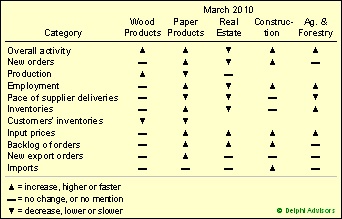1 min read
Forestry-related Industry Performance At a Glance: April 2010
 Suz-Anne Kinney
:
May 3, 2010
Suz-Anne Kinney
:
May 3, 2010

The ISM's report on industry performance in March indicates that overall activity for wood and paper products improved. For the wood products industry, increased production led the charge. New orders and a backlog of orders accounted for improvement in the paper products industry. Production in the paper industry retreated, however.
Shipments in the industry also increased. According to the Association of American Railroads' (AAR) Rail Time Indicators report, the volume of U.S. rail traffic rose from January to February, and is approaching 2009 levels. Year over year, both primary wood products and lumber showed an increase in shipped volumes in February.
ISM's report on service sector activity, as evidenced by the non-manufacturing index, was up 2.4 percent to 55.4, the fourth consecutive month of increases. Both construction and forestry shared in the gains.

Table 1. Performance overview for Forest-Related Industries.
Data source: Institute for Supply Management
U.S. exports of wood pulp, paper and paperboard in January fell from December 2009's level, which represented a 12-month high. Still, year over year, exports were 16 percent higher. Imports increased slightly on a year-over-year basis.
Lumber exports rose in January, up 2.4 percent. Lumber imports dropped 4.4 percent. On a year-over-year basis, both imports and exports increased modestly.
Positive indicators suggest that demand in the global forest, paper, and packaging sector will strengthen during 2010, according to a new report by the Deloitte Touche Tohmatsu (DTT) Global Manufacturing Industry Group. As the global economy shows signs of improvement, a moderate rise in sales from key end markets including construction and pulp will help the sector fare better in 2010. "Companies are taking a more disciplined approach in executing their corporate strategies," says Luc Martin, FP&P sector leader. "As a result, companies are better able to combat challenges of overcapacity and manage prices to anticipate future demand."
That's a look at the past. If you would like detailed information about the future of forest-related industries, subscribe to Forest2Market's Economic Outlook, a 24-month forecast of performance in GDP, currency exchange rates, housing starts, oil prices and more.
Let Forest2Market do the groundwork; subscribe to the Economic Outlook and focus your resources on identifying and acting on the strategic advantages you'll discover every month.





